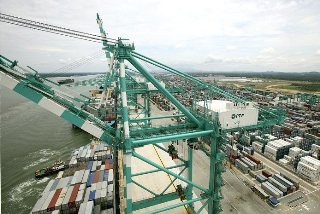 The Hague, Netherlands-based APM Terminals (APMT) made a strong first quarter performance, showing growth in both profit and revenue in line with an expansion in container volumes.
The Hague, Netherlands-based APM Terminals (APMT) made a strong first quarter performance, showing growth in both profit and revenue in line with an expansion in container volumes.
APMT posted a profit of US$215 million in the first three months of the year, a 29 percent improvement on the $166 million it made in the first quarter of 2013, while revenue went up by 5 percent to nearly $1.1 billion.
The positive growth was fueled by a 9 percent uptick in container throughput, reaching 9.4 million TEUs and beating the 4 percent growth on average logged by the market.
Profit, excluding divestment gains and impairment losses, was $217 million in the first quarter compared to $161 million for the same period last year.
The EBITDA (earnings before interest, taxes, depreciation, and amortization) margin improved significantly to 24.3 percent from the previous year’s 19.4 percent, supported by increased volume and operational efficiency.
“APM Terminals’ first quarter results reflect the company’s continuing focus on creating long-term customer value,” said company CEO Kim Fejfer. “Our ongoing efforts to optimize our portfolio through partnerships, capital efficiency, infrastructure investment and better operations underscores our confidence in our customers and the future potential of the port market.”
In Asia, among the portfolio developments it undertook in the quarter was the inauguration of berth 13 in the Southeast Asian hub of Tanjung Pelepas, Malaysia. The berth is equipped to handle the largest container vessels in operation and served the Triple-E vessel Maersk Mc-Kinney Moller in early April.
APM Terminals, the terminal-operating unit of A.P. Moller-Maersk, designs, builds, and operates a global terminal network of ports and inland services that now number 65 operating terminals, 16 terminals being upgraded and expanded, with seven new terminals in development. These port terminals are integrated with an inland service network that spans 165 locations in 47 countries.




